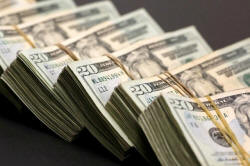Dollar drivers: what's boosting the buck?
 Send a link to a friend
Send a link to a friend
 [July 30, 2018]
By Saikat Chatterjee and Ritvik Carvalho [July 30, 2018]
By Saikat Chatterjee and Ritvik Carvalho
LONDON (Reuters) - This year's dollar rally
is three months old and, despite some clouds over the U.S. growth
outlook, the gains may have a bit further to go.
Since mid-April, the dollar has risen nearly 6 percent against a basket
of currencies, hurting emerging markets and inflicting losses on
speculators who had bet the currency would extend its 10 percent fall
from 2017.
Their bets paid off in the first quarter when the dollar tanked nearly 4
percent. But since then, signs of faltering growth elsewhere in the
globe and then the trade war outbreak have pushed capital towards the
United States.
Many remain convinced the dollar has had its day, noting U.S. economic
growth is likely to have peaked. But most of the analysts polled by
Reuters see the dollar's allure lasting another six months.
"The dollar outlook is the trillion-dollar question in foreign exchange
markets today as there are a lot of drivers at play simultaneously,"
said Borut Miklavcic, CIO at LindenGrove Capital, a London-based fund.
Below are some of the key factors driving the dollar.
(For a graphic on 'Central bank policy gap gives yield advantage to
U.S.' click https://reut.rs/2JTQxW7)

1/ MIND THE GAP
Interest rate differentials are big drivers for currencies. That driver
seemed to have broken down last year when the dollar fell, despite
higher interest rates and bond yields than Europe or Japan. Now the link
may be restored.
In early 2018, encouraging European data fostered a view of synchronised
economic recovery that could lead to interest rate rises. But that view
has dissipated - the Bank of England played down rate rise expectations
in April and a hike this week is unlikely to be followed up with more.
The European Central Bank also pledged in June to hold down interest
rates until past next summer. And few expect the Bank of Japan to signal
any retreat this week from its stimulus.
But the U.S. economy is growing strongly, even if the second quarter's 4
percent-plus rate is the peak. Nevertheless it should continue to expand
faster than peers.
"The gap in growth between the U.S. and the rest of the world has
increased, as has the gap in central bank policy," said Roberto
Coronado, senior portfolio manager at PineBridge Investments.
In comparison, the European Commission has trimmed 2018 euro zone growth
forecasts to 2.1 percent from 2.3 percent. Japan's economy is expected
to rebound modestly in the June quarter after contracting in the first
quarter.
"The U.S. economy is pointing towards a strong rebound in Q2 while in
the rest of the world there is nothing pointing to a rebound," Coronado
added.
(For a graphic on 'U.S. companies repatriated about $300bn in Q1 2018'
click https://reut.rs/2mKlZwM)
3/ REPATRIATION
Repatriation flows from U.S. companies holding large amounts in dollars
overseas may be helping support the currency.
New U.S. regulation whereby companies are taxed on profits accumulated
abroad, irrespective of where the cash is held has encouraged such
companies to start "repatriating" an estimated $3.3 trillion of funds
stashed overseas.
U.S. balance of payments data shows some $300 billion of such earnings
was repatriated in the first quarter. Those flows did not boost the
greenback, because the money was believed largely to be in dollars
already, but that may change in coming quarters.
[to top of second column] |

Bundles of banknotes of U.S. Dollar are pictured at a currency
exchange shop in Ciudad Juarez, Mexico, January 15, 2018.
REUTERS/Jose Luis Gonzalez/File Photo

"We expect a pick-up in non-dollar repatriation and a sustained increase in net
direct investment flows to support the dollar," Bank of America Merrill Lynch
said.
(For a graphic on 'U.S. economy likely peaked in Q2 2018' click https://reut.rs/2JSYLxG)
3/TRADE WINDS
Protectionism may also be playing a role. The United States, whose exports
amount to 12 percent of its annual gross domestic product, looks less vulnerable
to trade war than, say, Germany, which has an export-GDP ratio around 45
percent.
The figures reflect gross exports as a percentage of annual output and not net
trade. Click the following link for an interactive version of this chart:
https://tmsnrt.rs/2Lzlk04
China's ratio is 20 percent and its annual exports to the United States are
worth $500 billion. But U.S. exports to China are $130 billion. This relative
insulation may offer another incentive to buy the greenback.
Morgan Stanley strategist Hans Redeker predicts the dollar rally will end soon,
but acknowledges "protectionism is likely to impact the rest of the world
first." So "the first-order effect could be dollar-positive, but ultimately net
dollar weakness would be the second-order impact," he said.
4/ EM OUTFLOWS
Support for the dollar has also come from the emerging market capital exodus. As
U.S. interest rates rise and China eases policy, trade-driven emerging economies
have seen capital outflows.
Emerging markets saw $14 billion in outflows in May and June, the Institute for
International Finance estimates. It provided no July figures, but emerging funds
have seen more outflows this month. Ordinarily, this cash would have gone to
safe-haven Japanese yen or Swiss franc, but this year higher-yielding U.S.
assets are benefiting.
(For a graphic on 'Dollar rally hits emerging markets' click
https://reut.rs/2LG13Fd)

5/ POSITIONS
But markets could soon turn wary if the build-up in dollar long positions tempts
investors to take profits.
Long dollar bets are at the biggest in more than a year and a half, with bets
tripling from April lows though they remain some way off the November 2014
record.
The latest increase in dollar long positions came as the dollar index retreated
one percent from one-year highs.
Derivatives also paint a slightly more circumspect picture, with three-month
risk reversals -- a ratio of calls to puts -- for the dollar against the yen
<JPY3MRR=> and the euro <EUR3MRR=> also below June highs.
(For a graphic on 'Long-dollar bets at highest in more than 1-1/2 months' click
https://reut.rs/2JVRbSG)
(Reporting by Saikat Chatterjee and Ritvik Carvalho; editing by Sujata Rao,
Larry King)
[© 2018 Thomson Reuters. All rights
reserved.] Copyright 2018 Reuters. All rights reserved. This material may not be published,
broadcast, rewritten or redistributed.
Thompson Reuters is solely responsible for this content. |